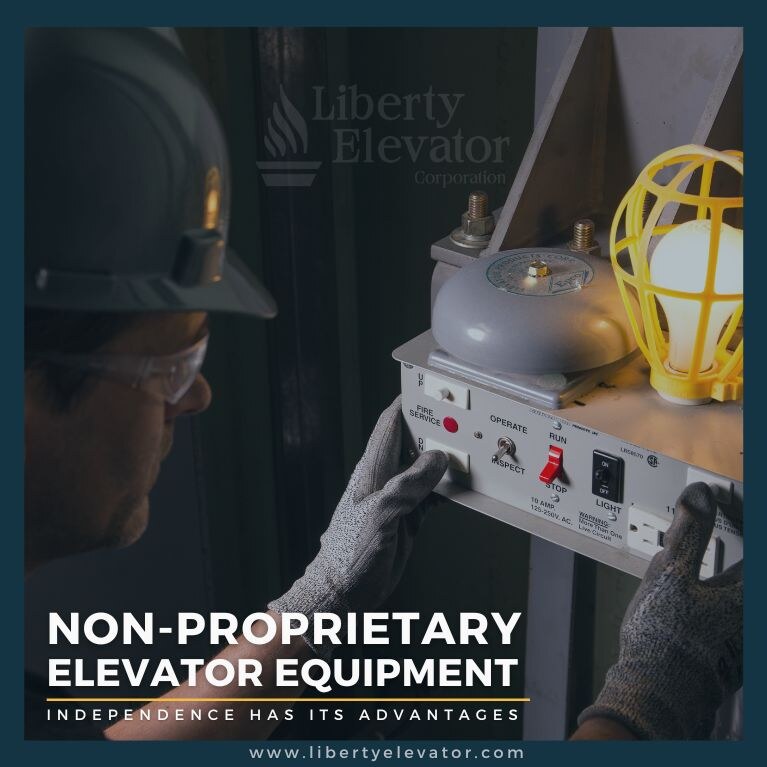Non-proprietary equipment, particularly in the context of elevators and other building systems, offer several benefits for building owners and operators. These advantages can greatly impact the cost, flexibility, and long-term management of the elevator equipment.
Selecting non-proprietary equipment when installing an elevator can yield long-term security for your property. This approach grants you the flexibility to independently source parts and to select from a wider range of maintenance companies without being constrained by exclusive service contracts from the original manufacturer for the life span of your elevator (20 - 30 years).
Proprietary vs. Non-Proprietary Equipment
Proprietary Equipment refers to something that is exclusive and only accessible by a specific person or company. In the elevator industry, this often refers to OEM (original equipment manufacturers) companies who sell a unique product, with protected software and requires exclusive tooling to maintain their branded elevator. Conversely, Non-Proprietary indicates that something is not protected by copyright, trademark, or patent, and is therefore open for anyone to use. The elevator industry standards are set by the “generic” and universally available products that are distributed by multiple manufactures and shared across the open market.
Proprietary – Belonging to only one person, unit, or group and not used by or available to others. Syn. Exclusive, sole, unshared, private.
Non-Proprietary – Not protected by trademark, patent, or copyright. Syn. Generic, universal, general, all-encompassing.
Independence Has Its Advantages
Unleash the power of choice! Non-proprietary equipment sets your building systems free from vendor shackles, opening doors to cost savings, flexibility, and empowered management. Here are some of the key benefits of non-proprietary equipment:
- Universal Standards: You’re not limited by custom OEM sizing of the shaft & equipment or exclusive tools that greatly reduce replacement and repair options over the life of the facility.
- Cost-Effectiveness: Non-proprietary equipment tends to be more expensive durring the initial installation phase, but maintenance and operation costs are less over the long-term. Competition among manufacturers and service providers can help keep prices competitive, and standardization often reduces the need for expensive custom solutions.
- Flexibility: Non-proprietary systems offer greater flexibility to building owners and operators. They are typically designed to be compatible with components and parts from various manufacturers, making it easier to find replacement parts and choose from a wider pool of service providers. This flexibility can result in cost savings and reduce the risk of downtime due to part availability issues.
- Vendor Neutrality: Building owners are not locked into a single manufacturer or service provider when using non-proprietary equipment. This vendor neutrality means that they can choose from a range of service providers based on factors such as cost, reputation, and service quality. It also reduces the risk of being dependent on a single supplier.
- Easier Compliance: Non-proprietary equipment often adheres to industry standards and regulations. This can simplify compliance with safety, accessibility, and other building codes. Inspections and upgrades are typically more straightforward when equipment follows recognized standards.
- Interoperability: Non-proprietary systems are more likely to support open communication protocols and interfaces, which can facilitate integration with other building systems such as access control, HVAC, and security. This interoperability can enhance the overall functionality and efficiency of a building.
- Future-Proofing: Non-proprietary systems are generally better equipped to adapt to technological advancements. Building owners can upgrade individual components or subsystems without needing a complete overhaul of the entire system, thus extending the life of the equipment.
- Reduced Long-Term Costs: Because non-proprietary systems allow for competitive pricing, flexible servicing options, and easier access to replacement parts, they often result in reduced long-term ownership and operational costs.
- Minimized Risk: Relying on non-proprietary equipment reduces the risk associated with a single manufacturer's financial stability or product discontinuation. If a manufacturer goes out of business or discontinues a product line, it's easier to transition to alternative solutions.
- Wider Industry Expertise: With non-proprietary systems, there is typically a broader pool of technicians and professionals with expertise in servicing and maintaining the equipment, reducing the risk of a shortage of skilled service providers.
Overall, non-proprietary equipment offers greater cost control, flexibility, and peace of mind for building owners and operators. It allows you to make choices based on your specific needs and budget constraints while minimizing the risks associated with proprietary systems and single-source dependency.
Don't Get Caught In The OEM Trap
Many of the industry’s globalized elevator manufacturers produce proprietarily designed equipment that allows them to keep their cost low while locking the end users into a long term service agreements and exclusive equipment, potentially, for the lifetime of the elevator. Once installed, the maintenance of many OEM elevators requires special tools, keys, & knowledge that limits most other elevator service companies from being able to easily maintain the elevator. Due to the exclusive distribution of parts, the original manufacturer can charge a premium for any equipment that an outside service provider may need.
In essence, although the equipment may be cheaper at the time of installation, in the long run, the end-user will be paying more to maintain and repair the equipment if they don’t utilize the original installer as their service provider.
Open Access to Elevator Parts
Your elevator has many parts and over time it will experience normal wear and tear. Therefore, to keep your elevator safe and up to code, you will need to replace old parts before they reach critical failure. A non-proprietary elevator system will allow you to easily find and purchase the parts to fix your elevator from a selection of vendors. Many non-proprietary parts are made by several different manufacturers, which allows you a choice of where to source your parts and keeps the costs down due to the open market and availability. One thing we all learned during the recent pandemic is that supply chain diversity is essential to running a business.
Restricted Availability & Planned Obsolesence
OEM’s make proprietary elevator equipment. This is equipment that’s made by them, serviced by them, and includes mechanically proprietary parts. So, when you need a new motor or integral part, you’ll have to purchase it from the original manufacturer. This may present a couple of glaring issues for building owners and managers. OEM’s control the lifecycle of their equipment by building in a “planned obsolescence”. Elevator equipment and parts that used to last 30 years, now can be discontinued in as few as three years. When essential parts are no longer manufactured, the costs can become considerably higher to repair the equipment as opposed to replacing it.
Second, many independent elevator companies simply can’t work on proprietary equipment. Either because they don’t have training and experience on the equipment, or they lack aftermarket tools and diagnostic software required to effectively troubleshoot, maintain, and repair them. When your elevator is down and only the OEM you purchased it from can service it, you are stuck in the unenviable position where one entity dictates the timeline and costs for repair. It’s under their control to charge inflated parts costs and a premium for labor rates, as you may feel you have no options.
Easier Elevator Maintenance
Using non-proprietary equipment for your elevator allows for easier maintenance. Unlike proprietary equipment, which may require a technician to have special tools and knowledge, non-proprietary equipment can be maintained by any technician who is properly trained.
Non-proprietary equipment also allows for faster repairs, which means less downtime. Non-proprietary elevator equipment has diagnostics built into the system, which removes the requirement of needing an additional specialty tool. These grant building owners the freedom to select a local elevator company for repairs and maintenance based on customer satisfaction and reputation instead of being locked to a specific company because they have the required service tools. Companies who manufacture non-proprietary elevator equipment offer high quality technical training, which results in service technicians who are qualified and experienced for repairs, installation, and maintenance of these systems.
Additionally, because non-proprietary elevator equipment is relatively open sourced, spare parts, replacement manuals, and technical drawing are often readily available for any elevator service provider.
You Still Have Service Options
Just because your property has an Otis, Schindler, Thyssen (TKE) or Kone elevator, it doesn’t mean you don’t have options for service and parts. Many Union elevator service providers have mechanics on hand that have the proper training, tools & experience to work on most OEM equipment. We at Liberty find it essential to hire former OEM mechanics and to proactively train our service technicians on the latest industry equipment from all vendors.
Liberty Elevator only installs quality non-proprietary elevator equipment from some of the industry’s most recognized suppliers. We’ve also carefully assembled our team, specifically hiring individuals with vast elevator industry experience and who share in our passion for delivering unrivaled customer service. Our goal is to satisfy your vertical transportation needs while exceeding your expectations.
Reference Articles
Elevator Capital Planning: Link
Elevator Modernization: Link
Elevator Installation: Link
Download the One Sheet on Proprietary vs Non-Proprietary Equipment: Link


